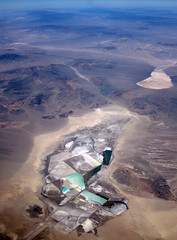 Image by dsearls via Flickr
Image by dsearls via Flickr We have discussed the development of Rodinia Lithium in past posts, and in the interests of full disclosure, we have a long position in Rodinia (TSX V:RM).
During this "second leg" of the lithium bull market, it seems timely to remind readers about Rodinia and it's developing deposits in both Clayton Valley, Nevada and it's other excellent properties in Argentina, all of which show huge deposits, and potential, and three of which are in the top 25 properties worldwide.
Rodinia is the largest, unaffiliated, brine and clay junior on the market today and is well positioned as a possible takeover target in the same way Salares Lithium (which we told you about in the spring and summer) was recently taken over by Talison Lithium of Australia, the #1 pure lithium producer in the world today.
Talison acquired Salares for it's 108 hectare "Salares 7" project in Chile to advance its position in the growing Brine projects of Chile, Argentina and Bolivia. Talison, having a 25 year jump on other producers, mines Lithium and Lithium carbonate from Spodomen (hard rock) at its Greenbushes property in Australia and processes the raw material in its two plants there. They have 300 customers worldwide, and provide 75% of imports into China.
Rodinia has a similiar stake in its properties in Argentina, (Salar De Diabillios) that Salares had in Chile. Rodinia also has a large clay property at Clayton Valley, Nevada, nearby the largest lithium production facility in the USA.
This should draw interests from North American companies in particular, as Clayton Valley is the largest clay deposit in North America, and is well positioned both geographically and politically, for rapid development.
Here is the lowdown on Rodinias pipeline projects:
(1) Clayton Valley Project
Esmeralda County, Nevada
Clayton Valley
Non NI 43-101 Compliant
| HIGHLIGHTS | |
| Location: | Approximately 70 km west of Goldfield, and approximately 88 km southwest of Tonopah |
| Mineral: | Lithium brine (lithium hectorite and lithium spodumene potential) |
| Property Size: | 50,440 acres |
| Stage of Development: | Exploration – initial drill and seismic program completed |
| Current Work Program: | Expanded drill program, additional gravity and 2D seismic |
| Potential: | Low cost, lithium brine producer |
| Ownership: | Option to acquire 100%, subject to a 3% Li2CO3 royalty |
 Clayton Valley is located in the centre of Esmeralda County, Nevada, approximately 70 kilometres west of Goldfield, the county seat, and approximately 88 kilometers southwest of Tonopath the largest nearby town.
Clayton Valley is located in the centre of Esmeralda County, Nevada, approximately 70 kilometres west of Goldfield, the county seat, and approximately 88 kilometers southwest of Tonopath the largest nearby town.The property consists of 250 (20 acre) claims on BLM administered land totaling 5,000 acres and an additional 284 placer claims totaling 45,440 acres. The combined area is now approximately 50,440 acres.
The claims fall on Goat Island and Paymaster Ridge.
Property History
Clayton Valley is home to the only lithium producer in the United States. This plant extracts lithium from brines pumped from aquifers below the valley and has been in production since 1967. The plant is designed to produce 1.2 million kg of lithium per year and to date has produced an estimated 50 million kg of lithium. Rodinia’s property is adjacent to this production facility.
In 1975, I.A. Kunasz of the American Institute of Mining, estimated the mineral endowment of Clayton Valley to be 750 million kg of lithium. A more recent study by Price, Lechler, Lear and Giles in 2000, suggests that significantly more lithium was released into the Clayton Valley catchment by the weathering of high lithium bearing rocks. They suggest that as groundwater enters the basin, it appears to be dissolving lithium minerals accumulated in valley sediment and is partially recharging the lithium content of the brine, while mining operations have been ongoing.
Rodinia now has a total of 45,440 acres under its control, accounting for approximately 90% of the valley. The Company has planned an aggressive exploration program to target additional layers of lithium bearing brines which may exist throughout the property.
Property Geology
Over 30,000 years ago Clayton Valley was part of a very large lake that experienced volcanic activity resulting in the fall out of lithium rich ash. Sulfur acid resulting from volcanic gas emissions accelerated the leaching of the lithium rich rhyolites (unique to the Clayton Valley area).
The lake went through the same evaporation stage that the South American salares are currently experiencing. Approximately 8,000 years ago the evaporation stage was completed resulting in the current desert environment Note: Generalized cross section of Clayton Valley (from Davis, Friedman and Gleason, 1986 after Albers and Stewart 1972)
(2) Salar de Diablillos Project
Salta Argentina
Non NI 43-101 Compliant
| HIGHLIGHTS | |
| Location: | |
| Mineral: | Lithium brine |
| Property Size: | 2,700 hectares |
| Stage of Development: | Exploration |
| Current Work Program: | Reviewing initial drill and seismic testing plans |
| Potential: | Low cost, lithium brine producer |
| Ownership: | Option to acquire 100%, subject to a 1.5% NSR |



No comments:
Post a Comment